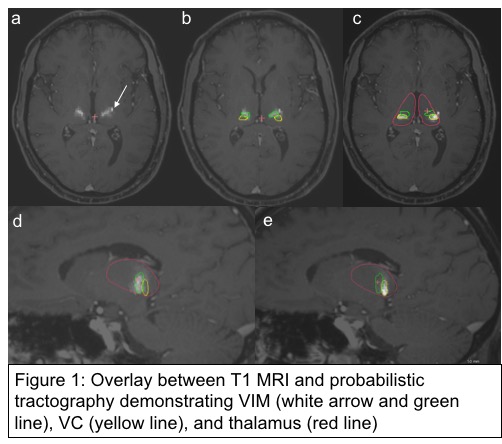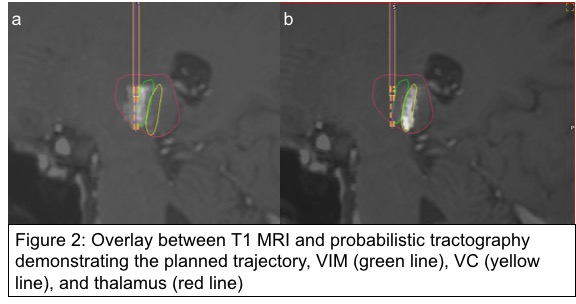Session Information
Date: Wednesday, September 25, 2019
Session Title: Surgical Therapy
Session Time: 1:15pm-2:45pm
Location: Les Muses Terrace, Level 3
Objective: To report the first prospective application of a specific tractography-based targeting in asleep DBS patients with essential tremor.
Background: The ventral intermediate nucleus (VIM) of the thalamus is not clearly visible on 3T MR imaging sequences. Therefore, traditional VIM targeting for DBS implantation depends on atlas-defined coordinates relative to AC and PC. However, there is considerable individual anatomic variability and therefore, lead implantation is typically performed with the patient awake to allow for intraoperative testing. For a subset of patients that cannot undergo awake procedures due to high amplitude tremor or claustrophobia, an asleep procedure may be necessary. Prior studies have demonstrated the ability of white-matter tractography to segment thalamic nuclei based on connectivity from cortical grey matter. We report here the first prospective application of such tractography-based targeting in asleep DBS patients with essential tremor (ET).
Method: For four patients, cortical masks of the primary motor cortex (PMC) and primary sensory cortex (PSC), and subcortical thalamic masks were automatically segmented based T1W scan using Freesurfer software. These segments were co-registered to DTI space using rigid body transformation technique with 6 degrees of freedom. Thalamic motor and sensory connectivity segmentation was performed on preprocessed DTI data using probabilistic tractography by selecting the cortical areas as initiation mask and thalamus as an inclusion mask. Voxels within the thalamus containing a higher density of fibers connected to PMC and PSC were segmented as VIM and VC, respectively, and used as landmarks during stereotactic planning (Figures 1 and 2).
Results: All patients underwent successful asleep bilateral DBS implantation. Indication for an asleep procedure was patient preference for all cases. Tractrography-based VIM coordinates were found to be slightly more medial and posterior than atlas-based coordinates. Mean follow-up was 9.7 weeks (2 – 20 weeks). All patients exhibited good tremor control since surgery, with no significant stimulation side effects. All patients reported to be satisfied with the outcome.
Conclusion: Advanced computer processing techniques, such as probabilistic tractography can be used as an additional tool for planning DBS electrode implantation, particularly in patients undergoing asleep procedures.
To cite this abstract in AMA style:
C. Matias, M. Alizadeh, J. Muller, A. Sharan, C. Wu. Tractography-based targeting of the ventral intermediate nucleus for asleep DBS implantation [abstract]. Mov Disord. 2019; 34 (suppl 2). https://www.mdsabstracts.org/abstract/tractography-based-targeting-of-the-ventral-intermediate-nucleus-for-asleep-dbs-implantation/. Accessed December 9, 2025.« Back to 2019 International Congress
MDS Abstracts - https://www.mdsabstracts.org/abstract/tractography-based-targeting-of-the-ventral-intermediate-nucleus-for-asleep-dbs-implantation/


